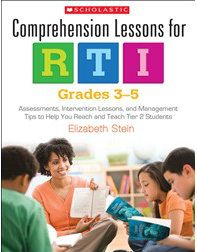Getting RTI Right
Comprehension Lessons for RTI (Grades 3-5):
Assessments, Intervention Lessons and Management Tips to Help You Reach and Teach Tier 2 Students
By Elizabeth Stein
(Scholastic, 2013 – Learn more)
RTI is not just something that’s nice to know about, it’s something we need to know, and Elizabeth Stein’s book is the best place to start.
RTI (Response to Intervention) has come to my school district at the same time as the Common Core (CC). As teachers, we sometimes feel like we’re building the airplane while it’s in flight. As I write curriculum geared to meet the CC Standards that I need to teach in my next unit, I’m also learning about RTI — and I’m expected to implement it. It’s wonderful to see a fellow teacher (Elizabeth Stein) coming to our support/rescue and clearly explaining what RTI is, what it can do for our students, and how it can inform our teaching.
As Stein says: “RTI is here. It is a commonsense approach to teaching and learning.” (pg. 7) Thanks to her book, we can clearly see how it is common sense, and how it is based on practices that we already have in place.
A conversation with an RTI master

What is RTI? Response to Intervention is all about effective instruction that provides students with opportunities to meet academic and personal goals. It’s about high-quality teaching and student achievement. RTI provides a framework for evaluating how students are responding to your instructional decisions and practices. (pg. 10)
Ideally, Stein writes, “the framework will broaden and strengthen your knowledge, awareness, and ability to provide high-quality instruction.” In Comprehension Lessons for RTI you’ll find not only a theoretical view of RTI, but importantly, a practical view with an emphasis on Tier 2 students.
What are Tier 2 students? “Students who continue to struggle within the whole-class setting of Tier 1 receive more intensive instruction that targets their needs based on performance level and rate of progress.” (pg. 13) This book focuses on strategies and instructional support for applying TIER 2 instruction in our classrooms.
When Elizabeth Stein says one of the greatest questions about RTI seems to be “how do I know if an instructional strategy is researched based,” I feel like she’s been sitting in on our grade-level meetings at my school. That’s exactly the question that is asked the most. Fortunately for us, this book is full of researched-based lessons for Tier 2 students struggling with reading. Lesson are provided in the following areas: vocabulary (chapter 4), fluency (chapter 5), and comprehension (chapter 6).
While not all of the lessons were new for me (the Synonym Links for vocabulary, Choral Reading for fluency, and Reciprocal Teaching for comprehension), there are many choices and the reproducibles for the lessons are located in the back of the book. A feature I especially liked was the chart in front of these chapters that had the following columns: if the students’ performance reveals (e.g., difficulty figuring out unknown words), then try (e.g., synonym links – pg. 73-74), to (e.g., encourage students to use the context to gain meaning and transfer understanding of words and concepts across a variety of texts and subject areas.) [pg. 67]
Formative assessment help
Chapter Three includes assessments to guide instruction and intervention. This chapter is especially helpful in clarifying the different assessments: universal screening for all students, progress monitoring for Tier 2 or 3, diagnostic for at-risk students at any tier, and outcome assessments (for all students).
Since the monitoring of students’ progress is the heart of the Tier 2 RTI process, this is a critical chapter that is well explained and includes a student scenario as well as steps to creating your own progress monitoring assessments. Formative assessments are also covered in this chapter since “formative assessments are a natural link to effective progress monitoring” (pg. 53). Stein also discusses portfolio assessments and how to set them up.
Chapter Two is entitled “RTI in the 21st Century.” In this chapter you will find topics covering RTI and the workshop approach, differentiating instruction within the RTI Tiers (including wonderful examples of every-student-responds strategies), and making the most of small-group instructional time. Chapters 4-6 address the specifics of Vocabulary, Fluency and Comprehension. (See the Table of Contents and several sample pages here.)
What I liked best about this book:
• It’s written in an easy-to-understand format with student scenarios for further clarification.
• It includes research based lessons and when best to use each lesson based on student needs.
• It mentions presenting information through multiple representations – visual and auditory, as well as through cooperative-learning activities (especially good for English Language Learners).
• It includes web sites for further information.
What I would have liked to have seen in this book:
• Some greater distinction among interventions/lessons that will work well with ESL students. For example, the vocabulary lesson “Anything Goes” uses rapid-fire style of questioning to talk about the meaning of words. This would not be an appropriate strategy for English Language Learners who often need the support of wait time.
Next suggested step for Elizabeth Stein:
Please create a similar book with a focus on math.
My next step:
Suggest at the district level that this book be purchased for each 3-5 grade level team in my district. This book will be invaluable as grade level teams meet and discuss the reading needs of Tier 2 students.
Julie Dermody, NBCT, is currently an ESL teacher in the Chapel Hill-Carrboro (NC) City Schools. She has also served as an elementary, middle and high school teacher, a reading specialist and a teacher of gifted students. Her article about ESL students, “Going for the Growth,” appeared in the September 2012 Educational Leadership (online edition). Julie recently presented at TESOL’s International Convention in March 2013 in Dallas, Texas. She writes and reviews regularly for MiddleWeb.





































